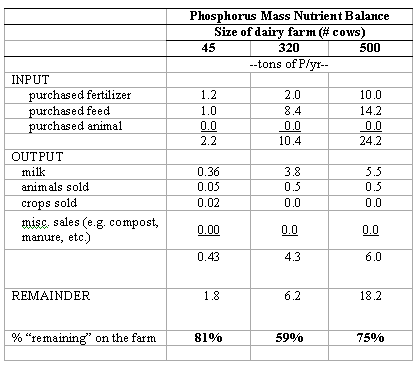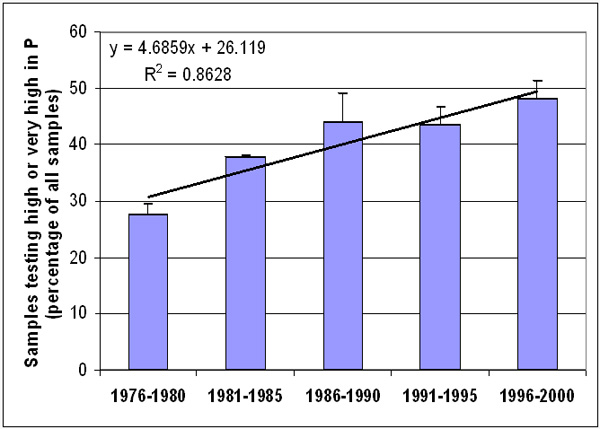Phosphorus can accumulate on farms if P inputs (e.g. purchased feeds, fertilizers, and livestock) are greater than P outputs (e.g. products shipped off the farm and losses to the environment). Such a measurement of inputs and outputs is called a mass nutrient balance.
Take a look at the mass nutrient balance study by Klausner (1997).

The study shows that roughly 60%-80% of the imported P is not exported from the farm through managed pathways. Mass nutrient balance measurements, such as this example, do not measure P losses to the environment. Instead, a portion of that P "remaining" on the farm will likely be lost to watercourses. The goal is to minimize the loss, encourage recycling of the P through crops and livestock, and reduce the amount imported in the first place, all in an economically feasible manner. While it's difficult to measure P losses, we can look at other indicators of nutrient loading on dairy farms to see if a nutrient imbalance is taking hold.
Consider the long term summary of soil test P data from the Cornell Nutrient Analysis Laboratory, below.

The graph shows that the portion of agricultural soils testing high or very high for P in New York State has increased from 27% to 47% over the last 30 years. While this trend has been common across a range of farms, what's changed in the dairy industry over that time that might have accelerated the increase in soil test P levels on dairy farms? Given that it's been most economical to improve crop yields and milk production through increased use of purchased fertilizers and feeds as well as the fact that phosphorus can accumulate in the soil, we are seeing the imbalance between imported P and exported P taking hold through rising soil P levels.
Are higher soil P levels a problem? Is the nutrient imbalance a problem? In the past, many thought managing excess P wasn't such a big deal, because they believed that (1) soil can hold an infinite amount of P, (2) P does not leach, and (3) erosion control will prevent P movement to watercourses. Therefore, P could "accumulate" in the soil and not be a problem. We now realize that soils are not bottomless pits and soil testing high in P can act as a source of P to watercourses. That is, the higher the soil test P, the more likely P will be lost to the environment.
What can we do to reduce P losses from dairy farms? In general, it's a mix of reducing losses from fields as well as reducing nutrient imports. Consider the four major enterprises on a dairy farm in the whole farm diagram, below: animals, manure, soil and crops, and storage. Think about changes that could be made in each that would result in fewer imported nutrients and/or losses from the farm.
Continue to the next page to for information about efficient use of P from soil, manure and fertilizer through Crop P Guidelines.